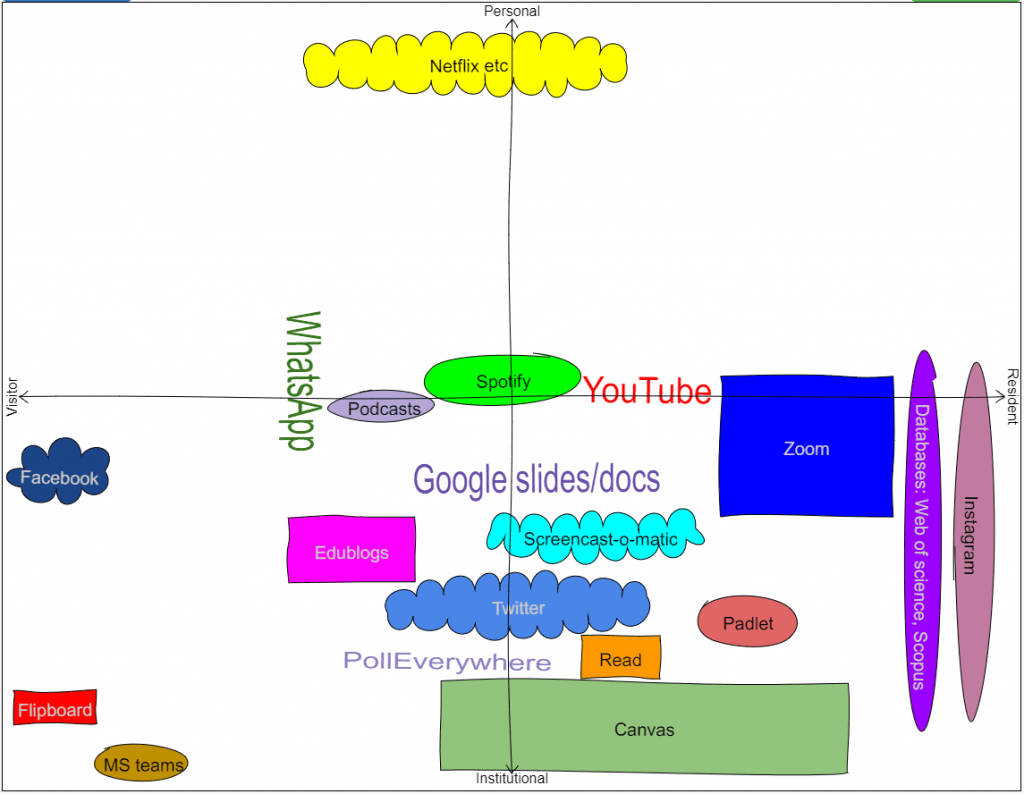
I feel my digital Visitor & Residents map in my bones! For the last year I have lived my life at work, in various digital space. Please don’t think the empty space in the ‘Personal’ half of the map is filled with digital-free escapades in nature. The truth is that empty space currently does not exist.
Creating the map has got me thinking about how it has changed over time. Up until March 2020, the mere suggestion of a Zoom meeting with a colleague oversees would have me in a complete dither and booking IT support. I had never heard of Screencast-o-matic, and Canvas was shiny and new…and confusing. A year on, and I navigate these with ease, and regularly support my colleagues to use these digital tools.
The concept of ‘Digital Natives and Digital Immigrants’ has seemed very real to me. I have been known to get my 12-yr old out of bed to help me get Netflix to work. (And I STILL need him to connect the car to Spotify…or connect Spotify to the car…whichever.) He could do all these things because he had grown up with them. I was too old to learn these new tricks.
However, reflecting on how my ability to wield digital tools has changed over the last 12 months, it is clear that just as David White and Alison Le Cornu (1) proposed, it is motivation and context rather than age or background that matters.
I still can’t figure out how to switch from one digital streaming service to another because I haven’t had the opportunity to spend any time learning how. However, I can record a video, edit out the fumbled words, add captions and upload it for my students to watch. And this is because I had the motivation (extrinsic mind you…) and context to spend the time with the digital tool.
(1) White, D. S., & Le Cornu, A. (2011). Visitors and Residents: A new typology for online engagement. First Monday, 16(9). https://doi.org/10.5210/fm.v16i9.3171

Hi Sam,
Thanks for sharing this reflection. I can completely relate to your experience with the digital T&L landscape for our students (yours in Dental school, mine: in Bioscience and Biomed). When I joined the teaching team in Pathology in 2019, my growing interest for educational research was in the current use of digital tools for the teaching of Pathology… Research was starting to document the efficacy of using virtual laboratory, online laboratory books, immersive virtual microscopy, virtual reality in the teaching of anatomy (refs. 1, 2, 3). Then the Covid-related digital teaching stroke, and instead of reading research about it, I had to implement it! Like you, I learnt on spot.
In theory, learning Pathology via online digital technology can optimize the quantity, quality, cost and accessibility of the T&L. Digital teaching is boosting students’ inclusion (2 students are from rural Victoria, and 1 is disabled). It has significant implications for the decentralization of tertiary education (ref. 4) and it creates opportunity to enroll students from overseas (fully online students are disseminated from New-Zealand, Taiwan, China and Japan).
However, there are some risks and challenges for increasing online teaching in my subject too quickly. Today, practical classes in Pathology are delivered in a dual way: 80 students are attending on campus while 10 students are fully enrolled online. I consider the experience of these online students with the students having the subject delivered face-to-face: I see that there is a challenge of reconciling the inconsistent experiences. This would dig a difference between the physical and virtual student experience and outcomes (I currently collect data to research this important aspect). I need to re-design the subject to align the digital T&L activities with, the microstructure of the classes, the feedback system, the assessment system, the learning objectives… this digital transformation did not happen during a rushed emergency response to the pandemic! I consider that we are still in a “remote” T&L of the subject, and not yet in a “digital delivery” of the subject. More time, more brain storming, more collaborations, more funding will be needed.
Other discussion points about the digital transformation of these practical classes can be (among so many!), 1) the training of the teaching team (me included!) to this new online landscape; 2) the evolution of current policies about student-teacher relationship, online safety, online etiquette, collusion, plagiarism, complaints, wellbeing; 3) students’ practical competency and technical skills. The challenge will be to deliver quality online teaching that will support the professional integration of future clinicians, researchers, critical thinkers, and citizen…
Let’s see how we can navigate in these new waters. The Online Facilitating course can only be eye-opening and constructive for me!
Looking forward to read you soon!
Sophie
Some refs…
1. A. Peña-Fernández, S. Fenoy, M.D. Evans, T. Sgamma, C. Hurtado, F. Izquierdo, M. Randles, C. Young, L. Acosta, C. Del Aguila (2018) Development of a virtual environment for teaching and learning biomedical techniques and equipment for the study of human pathogens, EDULEARN18 Proceedings, DOI: https://doi.org/10.21125/edulearn.2018.1704
2. D. Maguire, L. Dale. M. Pauli. Learning and teaching reimagined A new dawn for higher education? (2020) Joint Information Systems Committee (JISC) Reports: Learning and teaching reimagined: a new dawn for higher education? | Jisc
3. Marshall, R. (2004). Teaching and learning pathology: a critical review of the English literature. Medical education. https://doi.org/10.1111/j.1365-2923.2004.01775.x
4. S. Diwakar, D. Kumar, R. Radhamani, H. Sasidharakurup, N. Nizar, K. Achuthan, P. Nedungadi, R. Raman, and B. Nair. (2016) Complementing Education via Virtual Labs: Implementation and Deployment of Remote Laboratories and Usage Analysis in South Indian Villages. International Journal of Online and Biomedical Engineering.DOI: http://dx.doi.org/10.3991/ijoe.v12i03.5391